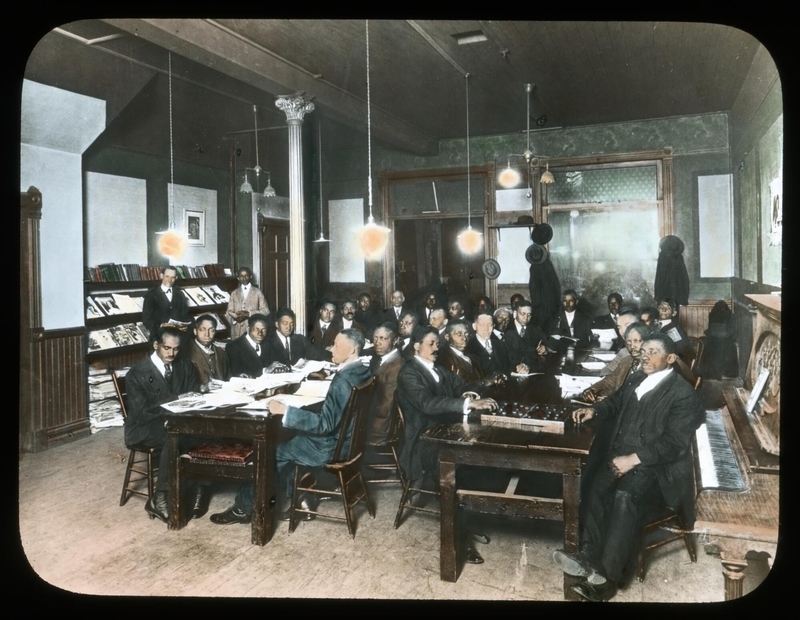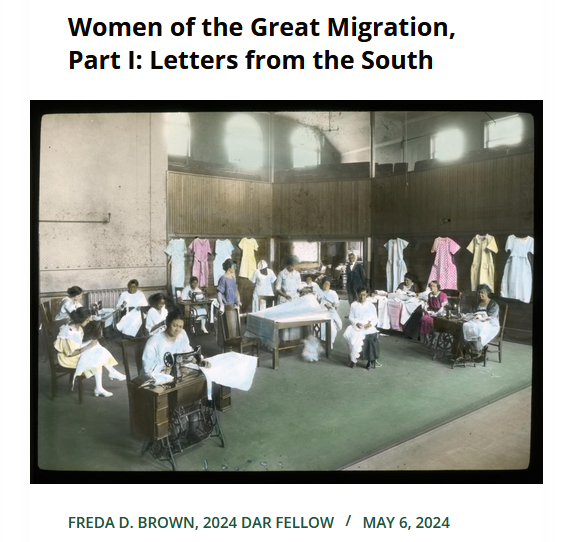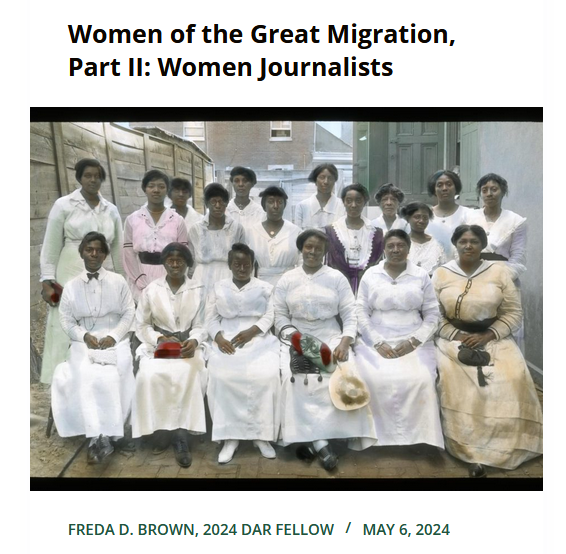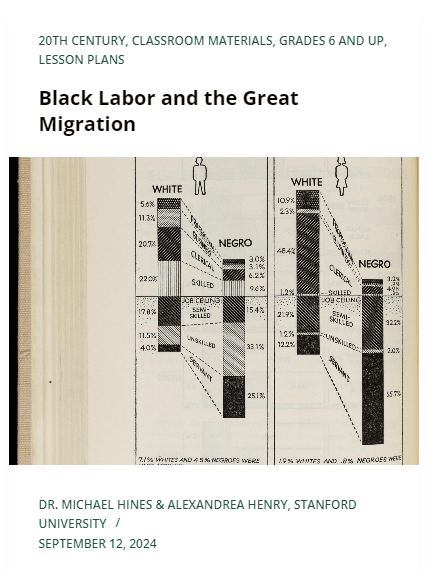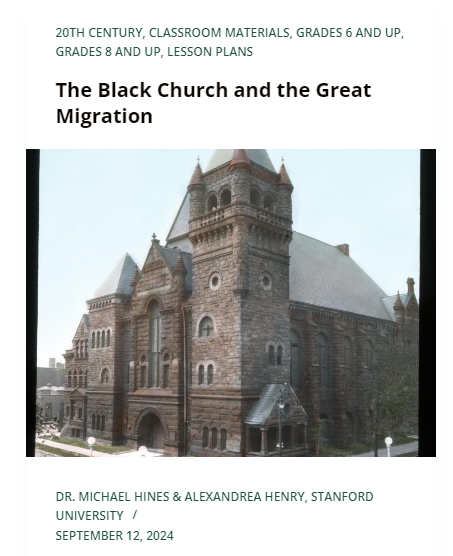This lesson is one of a series of classroom materials about the Great Migration, some generously funded by the Chicago Chapter, National Society Daughters of the American Revolution. Find the rest in the Related Resources tab!
This is the first of three lessons by Mrs. Freda D. Brown, School Library Media Specialist and Journalism Instructor at Kenwood Academy High School, on The Chicago Defender and the Great Migration.
Curriculum Connections: 20th Century, African American History, Great Migration, Jim Crow, Journalism, Race Relations, Racism, Women Journalists, Women’s Rights
Lesson Series Context and Framework
The Great Migration changed the makeup of many major American cities, but the intricacies of how this movement impacted everyday citizens are often under-explored.
Add to that the crucial role journalists played in helping African Americans navigate their migration North and their lives upon arrival, and there is much to explore. In particular, The Chicago Defender, under the leadership of its socially conscious founder Robert S. Abbott, exhibited extraordinary leadership during this movement, by encouraging the move North, publishing stories about career opportunities in Northern cities, and even employing Black women journalists on the Defender staff.
These lessons will explore the lives of the men, women, and children who lived in the South, but desired to move North in pursuit of a better future. In particular, they will emphasize the extraordinary challenges young girls and women experienced when migrating north, and their experiences once they arrived in northern cities.
These lessons will also emphasize the remarkable women journalists who reported for The Chicago Defender and the intersection of journalism and activism during the Great Migration, demonstrated by women like Ida B. Wells-Barnett and Ethel Payne. These women used their pens to highlight the realities of the struggles of everyday life in America during the Great Migration, and particularly the challenges and experiences African American women and young girls faced.
Lesson Series Learning Objectives:
- Students will examine the role the Chicago Defender newspaper played in encouraging African Americans to migrate North in search of economic opportunities.
- Students will evaluate the unique contributions of African American women journalists during the Great Migration.
Lesson Series Essential Questions:
- What would it take for you to leave everything you knew behind?
- How did two waves of Black migration impact the landscape of major US cities?
- What role did African American newspapers play before, during, and after the Great Migration?
- What major contributions to American culture can be attributed to the Great Migration?
- Why are there so few records of migration stories in the American archive?
- What role did the Great Migration play in shaping the American Dream story?
- What role did women play in the Great Migration?
This lesson was produced through a generous annual fellowship for digital education on American Women’s History or Early American History funded by the Chicago Chapter, National Society Daughters of the American Revolution, 2024.
Materials – Available for Download in the Downloads Tab:
- A copy of “The Chicago Defender as the North Star” lesson
- Copies of selected Chicago Defender articles
- Article analysis handout
Lesson duration: 100 minutes
Essential Questions:
- What do you know about The Chicago Defender and its founder, Robert S. Abbott?
- What would it take for you to leave everything you knew behind?
Learning Objectives:
- Students will examine the role The Chicago Defender newspaper played in encouraging African Americans to migrate North in search of economic opportunities.
- Students will evaluate the unique contributions of African American women journalists during the Great Migration.
Process
Day 1 (50 minutes)
Students will read and dissect quotes by Chicago Defender founder, Robert S. Abbott, to gain insight into his vision for his work as a journalist.
Pre-reading guidance from the teacher should remind students that The Chicago Defender was a primary communication artery in the Black community nationwide. There were few telephones, so people relied heavily on the coverage and trusted it.
On day one, the class will do a close read of a Defender article, “From Robert S. Abbott to John H. Sengstacke,” emphasizing the paper’s extraordinary leadership in Robert S. Abbott to John H. Sengstacke to learn about the mission, work, and impact of The Chicago Defender in the African American community. (20 minutes)
Next, the teacher will divide the class into small groups of 4 to discuss the following questions and significant quotes in the article. (30 mins)
Discussion Questions for Consideration:
- What principles of journalism did Abbott’s Defender subscribe to?
- What last impact did Abbott have on the city of Chicago because of and after the Great Migration?
Significant Quotes: Groups will discuss each quote and write a summary of what they believe each quote means.
- “He [Abbott] envisioned their physical movement out of the suppressive, exploitative shackles of the slave-tradition gutted south as the first step for the Race’s claim to the freedom that the Emancipation was intended to give them”.
- “The Defender had given Negroes dignity; they breathed the strength of solidarity in reading about their group and their common interests in fighting discrimination”.
- “Sengestacke’s task is to have the Negro of today seen through other than the dusty spectacles of past controversy”.
- “Our people have a date with history, we’ve got to move to meet it”.
Day 2 (50 minutes)
Students will complete a bellringer, wherein they review what they learned about The Chicago Defender in class the day before. More on bellringers here. (5 minutes)
Next, divide students into five small groups. Distribute copies of the following articles to each group:
- “Bound for the Promised Land,” printed in the Big Weekend Edition, Nov. 11, 1916
- “Why They Leave the South, The Lynching Record for 1916,” printed Jan. 6, 1917
- “Migration,” by W.J. Latham, printed Aug. 26, 1916
- “Boys Failure to Aid in Crop Harvest Causes Lynching,” printed Jan. 2, 1918
- “Thousands Flee South, Fear Mob Rule,” by Waldo Tyler, printed Dec. 16, 1922
In small groups, students will work with their group members to read and annotate their assigned article of The Chicago Defender to examine and identify the specific ways its coverage supported and encouraged Southern Blacks to migrate North and provide textual evidence from their articles on the handout. Each group will respond to discussion questions. (30 minutes)
Each group will share their responses with the rest of the class. (15 minutes)
Post header image: “Men in Reading Room, Scott Memorial Church, Detroit, Michigan” (1922?)
About the Author
Freda D. Brown is the School Library Media Specialist and Journalism Instructor at Kenwood Academy High School in Chicago, IL. She received a Bachelor of Arts Degree in English Literature from Tennessee State University, a Master of Arts in Education from Roosevelt University, and a Master of Science in Library and Information Science from Dominican University. With 23 years of experience as an educator, Mrs. Brown specializes in connecting people with the resources they need to be successful, whether that is a book, database, or an individual. She lives in Chicago with her awesomely funny husband and her even funnier son.
This lesson supports the following Common Core learning standards:
Analyze and evaluate the effectiveness of the structure an author uses in his or her exposition or argument, including whether the structure makes points clear, convincing, and engaging.
Determine an author’s point of view or purpose in a text in which the rhetoric is particularly effective, analyzing how style and content contribute to the power, persuasiveness or beauty of the text.
Integrate and evaluate multiple sources of information presented in diverse formats and media (e.g., visually, quantitatively, as well as in words) in order to address a question or solve a problem.
Integration of Knowledge and Ideas: Integrate and evaluate content presented in diverse formats and media, including visually and quantitatively, as well as in words.
Determine two or more central ideas of a text and analyze their development over the course of the text, including how they interact and build on one another to provide a complex analysis; provide an objective summary of the text.
Analyze a complex set of ideas or sequence of events and explain how specific individuals, ideas, or events interact and develop over the course of the text.
Download the following materials below:
- A copy of the lesson “The Chicago Defender as the North Star”
- Copies of selected Chicago Defender articles
- Article analysis handout



